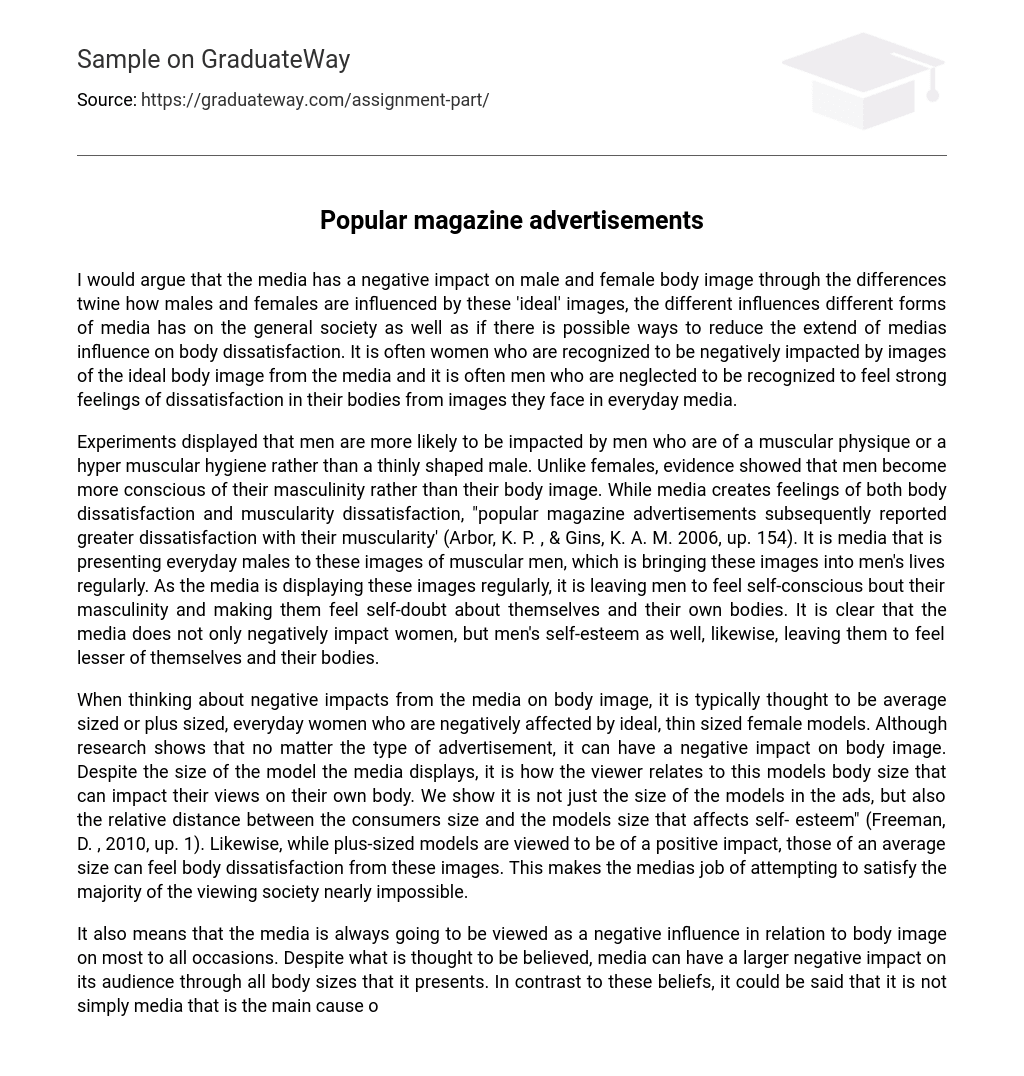I would argue that the media has a negative impact on male and female body image through the differences twine how males and females are influenced by these ‘ideal’ images, the different influences different forms of media has on the general society as well as if there is possible ways to reduce the extend of medias influence on body dissatisfaction. It is often women who are recognized to be negatively impacted by images of the ideal body image from the media and it is often men who are neglected to be recognized to feel strong feelings of dissatisfaction in their bodies from images they face in everyday media.
Experiments displayed that men are more likely to be impacted by men who are of a muscular physique or a hyper muscular hygiene rather than a thinly shaped male. Unlike females, evidence showed that men become more conscious of their masculinity rather than their body image. While media creates feelings of both body dissatisfaction and muscularity dissatisfaction, “popular magazine advertisements subsequently reported greater dissatisfaction with their muscularity’ (Arbor, K. P. , & Gins, K. A. M. 2006, up. 154). It is media that is presenting everyday males to these images of muscular men, which is bringing these images into men’s lives regularly. As the media is displaying these images regularly, it is leaving men to feel self-conscious bout their masculinity and making them feel self-doubt about themselves and their own bodies. It is clear that the media does not only negatively impact women, but men’s self-esteem as well, likewise, leaving them to feel lesser of themselves and their bodies.
When thinking about negative impacts from the media on body image, it is typically thought to be average sized or plus sized, everyday women who are negatively affected by ideal, thin sized female models. Although research shows that no matter the type of advertisement, it can have a negative impact on body image. Despite the size of the model the media displays, it is how the viewer relates to this models body size that can impact their views on their own body. We show it is not just the size of the models in the ads, but also the relative distance between the consumers size and the models size that affects self- esteem” (Freeman, D. , 2010, up. 1). Likewise, while plus-sized models are viewed to be of a positive impact, those of an average size can feel body dissatisfaction from these images. This makes the medias job of attempting to satisfy the majority of the viewing society nearly impossible.
It also means that the media is always going to be viewed as a negative influence in relation to body image on most to all occasions. Despite what is thought to be believed, media can have a larger negative impact on its audience through all body sizes that it presents. In contrast to these beliefs, it could be said that it is not simply media that is the main cause of body dissatisfaction, yet it is about the individual and how they portray whatever type of image that may be presented.
Some say, body dissatisfaction occurs from the predisposition of the individual’s body image issues and those with previous body-image dissatisfaction are likely to be more affected by medias ideal body images. In these beliefs it is concluding that the media is not to be blamed for the high rates of body dissatisfaction in males and females around the world, rather, that these feelings of dissatisfaction will only occur on the basis that previous issues of self-doubt of ones body image are existent and what they view in the media is to their own discretion.
As media is seen to have a negative contribution to body dissatisfaction, to what extent is it possible to change the way society views body image? Or is it even possible at all? Israeli has taken action and has adopted laws in which enforce that models have to have a body-mass index of at least 18. 5. This law was introduced to reduce the impact media has on eating disorders and anorexia rates in young women and in turn, reducing body dissatisfaction rates. “[We] Will from now on have a wider definition of a physical beauty’ (Onto, B. , 2013, up. 2).
If the media was forced to abide by limitations in what they present, it could cause a change in behavior of views and a rise in self confidence levels among he general public, as they are not being exposed to images which may influence them in a way that will make them feel negatively about themselves and their bodies. If there were to be limitations placed on all media resources involving body image and the ‘ideal’ bodies for both males and females, there could be a rise in self-confidence levels and therefore increasing the happiness of those in the global community.
We can conclude that it is the medias influence that impacts the views of body image and creates body and muscularity dissatisfaction among males and females around the globe. It is presented that the images that the media orators as the hard-to-achieve ‘ideal’ body image are one of the most prominent causes of body dissatisfaction as people are regularly exposed to it, making them feel poorly about themselves.





